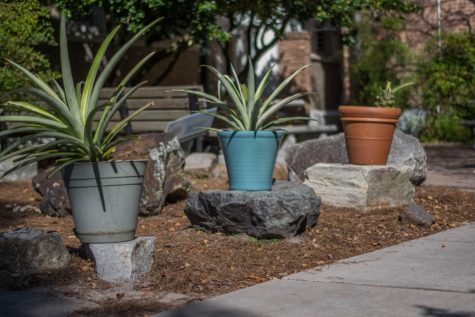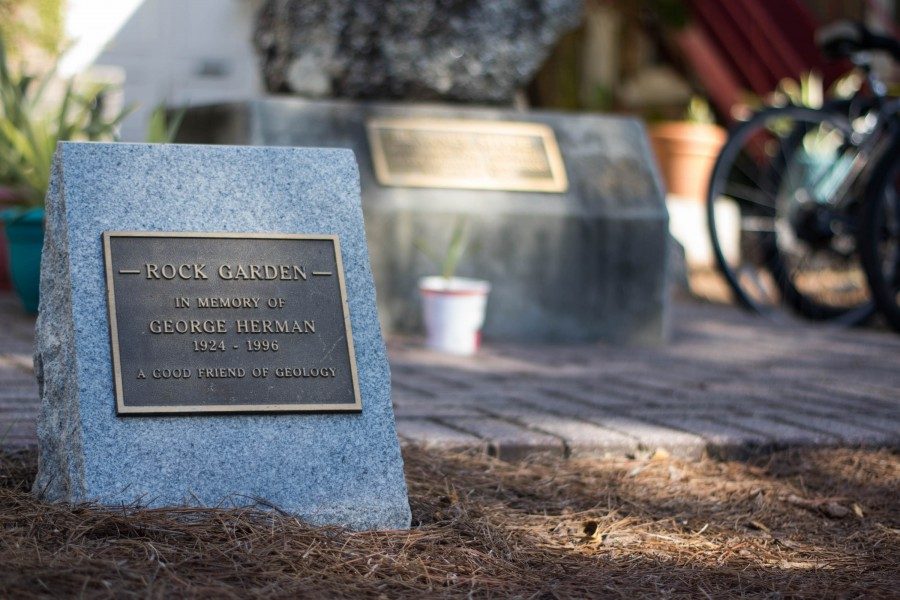Blessey Hall Rock Garden features historic natural rocks
In the 1980s a group of students hauled every rock it could find on the campus to a central location now known as the “Rock Garden.”
The closest natural rocks to Tulane’s campus lie nearly 5,000 feet below the ground. For geology students, this wasn’t going to cut it. Students decided to search the campus far and wide and brought natural rocks to the entrance of Dinwiddie Hall.
Many of the rocks collected by the students were from the 1884 World’s Fair that was held at Audubon Park.
“A lot of these big, black rocks are franklinite from the Franklin Quarry in New Jersey, and so they must have had some kind of exhibit on that or something,” Stephen Nelson, earth and environmental sciences associate professor, said.
Other rocks in the garden were collected from field trips taken by students and faculty over the years. Nancy Dawers, chair of the Department of Earth and Environmental Sciences, recognized the importance of having the rocks all together in one place.
“It was a more appropriate place for them amongst the geologists,” Dawers said.
Among the rocks in the rock garden, there is one that stands out more than the others. A rock known as the Blarney stone can be found at the front of the garden on a pedestal. According to Nelson, the Blarney stone was acquired by the Civil Engineering Department in 1945 but was regularly stolen by both the Geology Department and the business school.

The rock garden is also home to several pineapple plants, which belong to the Physics Department. The pineapple plants benefit from the full sun of the rock garden.
In the ’80s when students were bringing rocks to the front of Dinwiddie, the Blarney stone was among them. Nelson recalls that when the Engineering Department tried to take the rock back, it was not even able to identify what type of rock it was.
After Hurricane Katrina, when the Department of Civil and Environmental Engineering was closed, the new Earth and Environmental Sciences Department moved into its current home in Blessey Hall where the rock garden now resides.
“I was department chair at the time of the move, so I had to make sure that all of those rocks – that was part of the bargain, we move, you gotta move our rocks too so they all got moved over, including the petrified wood if you’ve seen that out front,” Nelson said. “And then several negotiations went on, and I finally gave up the petrified wood.”
Rocks are not the only thing that can be found in the garden. Amid the rocks are some pineapple plants that belong to the Physics Department.
“If [the pineapples] get out of control there will be some war that will take place,” Nelson said.
Students and faculty in the Geology Department hold the rock garden and its history close to their hearts and continue to add to it whenever they can from various field trips.
Jeffrey Agnew, Earth and Environmental Sciences professor, hopes to be able to incorporate the rock garden into some of his curriculum.
“One cool thing about rocks outside is that they weather and you can see some moss and lichen on the rocks, the rocks are discolored,” Agnew said. “You know, the rocks that we have in the lab are nice and clean.”
With a broad span of ages and types of rocks in the rock garden, Nelson jokes all they have to do now is get rid of the bicycle rack obstructing the view.
Your donation will support the student journalists of Tulane University. Your contribution will allow us to purchase equipment and cover our annual website hosting costs.




Robert Young • Jan 25, 2019 at 8:15 pm
We discovered the rocks on our recent visit to your campus. We were curious about them, so thank you very much for this article. It would be really nice to have the rocks identified, either at the site or online somewhere. Very interesting!